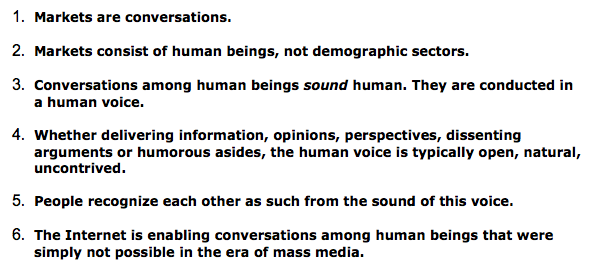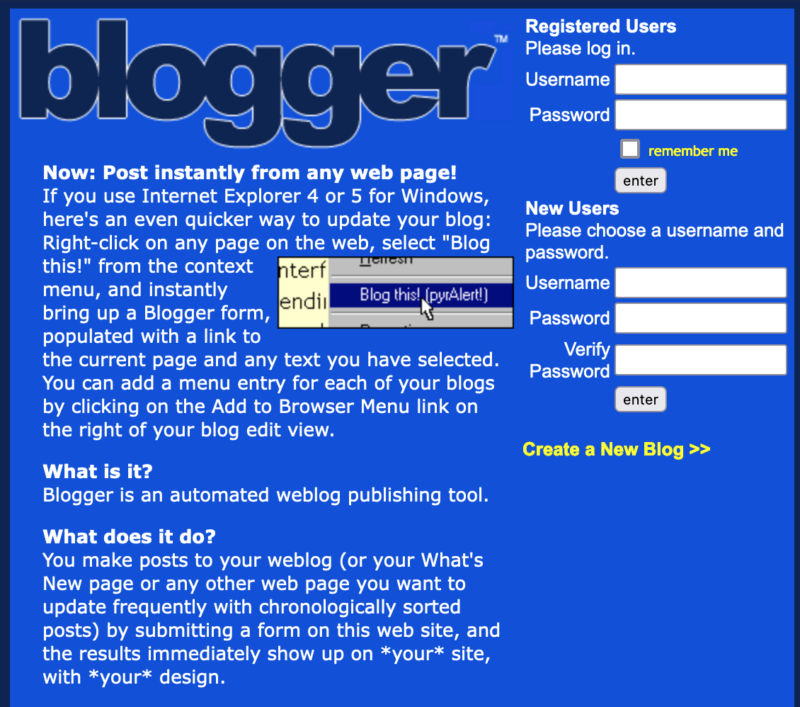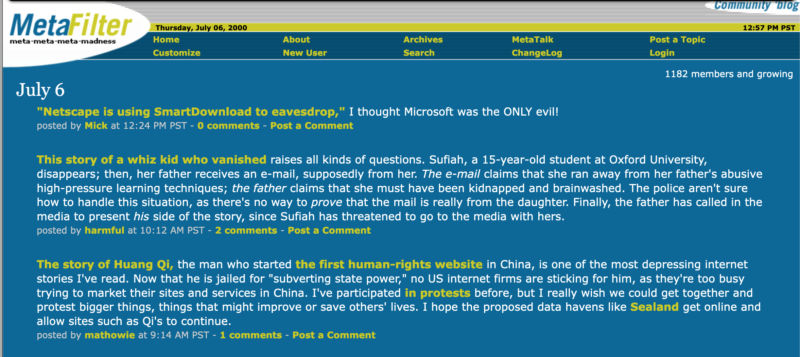Napster was released by two teenagers—Shawn Fanning and Sean Parker—from their dorm room. It’s peer to peer technology let college students swap music over a network, with anyone else in the world. It was a simple premise, one rested on a fundamental belief about technology: computers create community. In a short time, Napster—and its simple premise—would throw the entire music industry into upheaval.
1999, the year of Napster’s release, was an important year for community. If you could give people the means to publish on the web, many believed that something like a global, shared, utopic digital gathering of peers felt possible. That year saw the release of a number of sites approaching community from different angles.
The Cluetrain Manifesto was a new age business take on community. The website itself featured a collection of ninety-five theses (modeled on Martin Luther’s 95 Theses). The site’s creators—a set of four businessmen and writers—used the list of theses to reframe modern business in the context of an evolving internet. “Markets are conversations,” read the first one. According to the writers of the theses, conversations enabled by the web were, in turn, reshaping markets for everyday individuals, giving them access to information previously only held by the business elite.

The site invited others to participate in its authorship, through comment threads and a public petition (sort of like a guestbook). But the site’s creators also generated conversation outside of the site through a web of blog posts, news articles, and link rolls. By making the website a conversation through the mechanics of the web, it provided its very first thesis; a community of shared outward interest. The Cluetrain Mainfesto’s deft use of an emerging network of blogs became its most memorable contribution.
Blogging, as a concept, had been around for years. It was on the minds of Meg Hourihan and Evan Williams when they created the web design shop Pyra Labs in 1997. Hourihan and Williams were united by the draw of the web as a place of shared discovery and connection. Out of some early experimentation with the web platform, they created a dead-simple web publishing tool they called Blogger.
Blogger removed a lot of the complexity of publishing online. There were other tools for creating websites; Geocities, Tripod, LiveJournal, and the like. But Blogger was about as simple as it came. And Blogger was for blogs.
Users could log on, fill out a title and a textbox, click “Publish,” and have their blog post on the web. Blogger replaced the complexity of hand-editing HTML and uploading it to servers with a clean and simple tool. Within a year, they had a hosted version known as Blogspot as well. It gave people without a background in technology the ability to plug into a growing and thriving community which would be known, first ironically and then sincerely, as the “blogosphere.”

All of a sudden, blogs began to dominate the global conversation. Mostly young writers published frequently, sometimes in short streams of links, sometimes in long essays. There wasn’t a set format, or editorial board, or any of the traditional barriers to entry. And most importantly, writers linked to one another often, connecting bits of the blogging universe together into a loose network of peers. Writers collected large followings through (digital) word of mouth. Political blogs were a major part of the early 2000’s, and they even supplanted some mainstream coverage.
Blogs, on their own, are just websites. But blogs banded together by the types of commenting and linkrolls that platforms like Blogger made possible were something else entirely. They were a community.
Matthew Haughey worked at Pyra Labs. He was on the team, along with Paul Basch Jack Dorsey, and others, that helped created the Blogger software. But before it took off, he left to explore a different dimension of community. One that was more centrally linked than the universe of blogs. At the time, Haughey recalls his attempt to bring the experience of blogging to a more connected, single website that acts as a meeting ground for individuals.
The site was called Metafilter; its first version was launched in the spring of 1999. Any user could come to Metafilter and post a link, covering “anything and everything about interesting sites found on the web,” as Haughey first described it on his blog. Visitors could clickthrough to the link, of course. But they could also—and this is where the site became powerful—come back to the post and discuss it with other people on Metafilter in threaded comments.

It’s a format likely familiar to modern day web-surfers (think a proto-Reddit), but in 1999 it was still a novel idea. Bringing strangers together like that, Metafilter had the same potential as any other site to descend into a twisted knot of poisonous and hurtful language. But throughout it’s history, it’s been able to avoid that pitfall. And that’s largely thanks to the community that uses it.
In fact, the community itself was so tight nit that they ended up with a moniker of their own, Mefites. Over the years, during times of crisis or unrest around the world, Metafilter has become a place of discussion and even, on occasion, shared grief. There are stories of members who got married, who found long-lost friends, who aided one another in crisis. One article recalls a particular daring rescue by a group of “Mefites” to save several young women from a sex trafficking ring. There are many ways to describe the Metafilter community, but I find this paragraph from Hazlitt sums it up rather well (if not all that conciesely):
The MetaFilter community comprises feminists, computer engineers, current and former liberal arts nerds, thick-skulled autodidacts, at least two or three pretty famous science fiction writers, a European phage researcher, a New Orleans undertaker, this guy, design geeks, MMORPG nerds, geeks and nerds of all description, people who work at Walmart, Starbucks, and McDonald’s, dads, moms, at least one person in Antarctica, factory workers, small-town politicians, unemployed people, this woman, small business owners, pastors, people in porn, aid workers in Africa, him, her, 13-(almost-14)-year-olds, retirees, bedbound people, and people with no particularly noteworthy traits beyond their prolific raconteurishness, their devastatingly true evenkeeledness, or their nuanced views on how to find your passion or how to dump a motherfucking asshole.
Underneath it all are the moderators, the lifeblood of the Metafilter community. They are often plucked from the threads of the site and given jobs. Every comment is read by a moderator, regular people able to make nuanced decisions about what remains on the site and what gets tossed.
Metafilter’s combination of a fiercely passionate user base, meaningful online connection, ease of use, norms and practices created by its users, and of course, moderators, contributed to a vision of online community popular on the early web. There was some that believed Metafilter arranged the pieces in just the right way. They had created the utopic vision of the most optimistic futurists and technologists. There was a sense that this could be the web’s future, a shared communal spirit of helpfulness and upliftment.
And that is the sotry of 1999, at least for community. One that looked forward to a world of options and possibilities.
By the end of of 1999, community was already becoming a buzz-word, though other centralized platforms were coming online. Already, AsianAve was demonstrating the possibility of early social networks, and in 2001, BlackPlanet launched to an even wider audience. By the mid-2000’s, sites like MySpace and Friendster would bring the concept to a general audience, and a new version of community would emerge, one that is far closer to our modern understanding of it.
In 2001, Omar Wasow launched the social media platform BlackPlanet, building on the success of partner site AsianAve. Together, these site’s would prove the value of community.


Leave a Reply